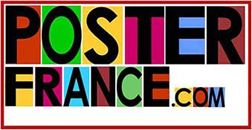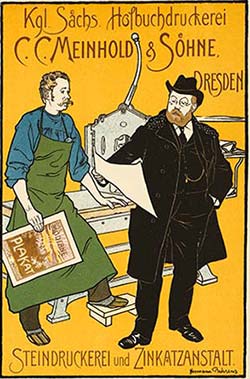
1 - Stone Lithography
2 - Offset Lithography
3 - A poster is not just a lithograph
4 - What is an "original" poster
5 - Linenbacking explained
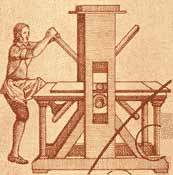
Part 1 - Stone Lithography
".........Lithography was invented in 1798 by Aloys Senefelder. This printing process is based on the principle that oil and water do not mix. An artist begins with a smooth block of limestone ("lithos" = stone). Not all limestone works; stone from the Bavarian quarries where Senefelder developed the process is needed. The artist begins by drawing on the stone with a greasy lithographer's crayon, or with a more powerful medium called "tusche". Tusche can be brushed on like ink or applied with a pen for different effects.
Lithography is unique among printmaking techniques in the way that it allows the artist to draw freely on the stone. Artists from a wide variety of media other than printmaking are drawn to lithography because of the directness of its process. After the artist has completed his drawing, the stone is chemically treated to fix the image securely. The grease in the lithographer's crayon or tusche will repel water during the lithographic process. The unmarked, grease-free surface of the stone, on the other hand, will absorb water.
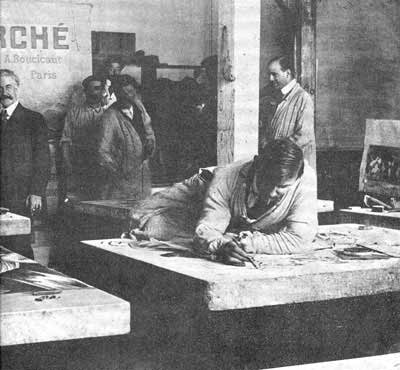
Master Lithographer painting on limestone
In the next step, the entire stone is cleaned with turpentine or a similar solvent. The artist's drawing is then no longer visible on the stone. The printmaker (normally the printing is not done by the artist himself) wipes the stone with a wet sponge prior to applying the ink. The portion of the stone's surface which absorbed the water from the sponge will repel the oil-based ink; the rest, which was marked with greasy crayon or tusche and thus repelled the water, will now accept and retain the ink. By this means, the artist makes the stone accept ink in places where it is desired, but reject ink in those spaces he or she wishes to remain empty white space.
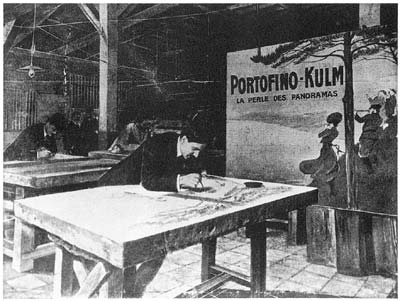
Leonetto Cappiello at Vercasson Imprimerie working on a limestone
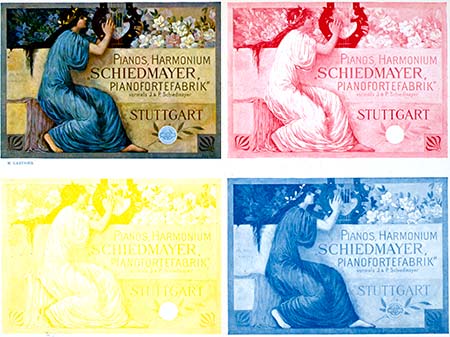
3 Color passes from the Stones used to make the final image (upper left)
Here above is an example of the finished plate taken from Das Moderne Plakat. The finished Plate is at the top left. Only 3 Stones were used to make this final product. No Black was used. The combinations of colors such as yellow and blue laying over each other make green or blue and red the lavender of the robe she is sitting on. Combinations and intensity of the amount of ink that the stone applies with any color create the finished color. The paper being white acts as a buffer to light and dark. Each color has a pass and the paper is then dried before passing on the next stone.
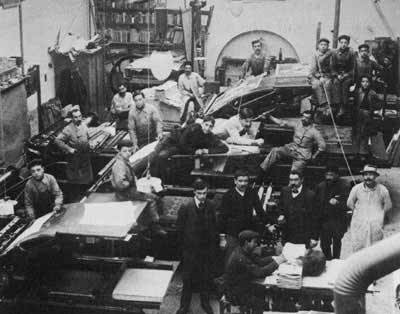
Imprimerie Karcher c1910 (karcher bros with suits)
The printmaker then uses a lithographic press to force the paper against the ink. Since lithography stones do not wear out like the copper plates used in etching, this process of wetting, inking and pressing the stone can be repeated many times. Along with this capability of producing multiple impressions, lithography excels at creating areas of vivid, solid color as well as subtle shading effects. Because of this, it has appealed to painters such as Toulouse-Lautrec, who turned to multicolor lithography to achieve a widely reproducible art. A separate stone must be produced for each color , and the paper then carefully aligned for the multiple pressings required to match up the different colors on the same printed sheet.............."
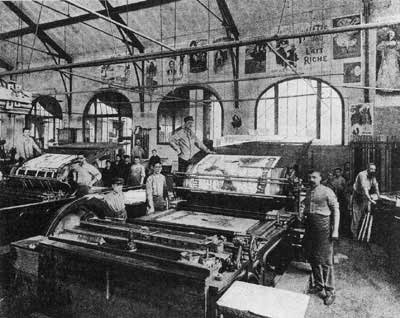
Posters rolling through presses c 1920's
Part 2 - Offset Lithography
It may also be a method known as drypoint where the maitre imprimer or artist etches into a metal plate lightly, very much the way a stone lithograph was prepared. The difference is that its on zinc plates, one for each color and the artistic result is similar to a stone lithograph. At first presses were flat before they applied the plates to round drums for efficiency.

A "blowup" of a "quadrichrome" or 4 color offset lithograph section, circa 1950 Italian. Note that the dots are "mechanically" aligned to blend together to create a complete spectrum of color using the white backround as part of the blend.
Offset lithography may begin with a photograph or scan of something. It can also be a photograph of an original painting, or a gouache. In the laboratory the photograph or scan is separated by a special camera and today by computer, into the four basic color elements- red, yellow, blue and black. A negative is then made for each color. In the print shop the four color negatives are used to produce four painting plates. The structure of the images on these plates is that of photo-mechanically spaced dots.
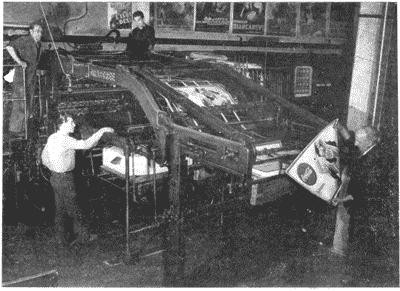
"Industrie Grafiche Moneta" of Milano, an important offset printer in 1950. This machine gives you an idea of what offset lithography looked like at the time. Notice the posters being printed for "Coca Cola" and the many movie posters on the wall.
These plates are then mounted on a four-color press and all four colors are printed simultaneously. In viewing a print produced in the above manner through a magnifying glass, the four standard colored inks will appear as dots neatly arranged in rows. This tells you the plates were made photomechanically, and almost all publicity posters in France and Italy after world war 2 were created using this process. From Gino Boccasile's "Lauro Olivo" to Cassandre's "Venezia" this was the process of the day.
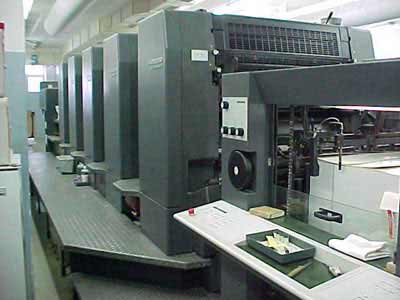
2003 Modern Heidelberg Speedmaster (5 colors)
Part 3 - A Poster is not just a Lithograph
Lithography can be made not only from stones, but also early in the 20th century the images were transfered to metal zinc plates which were at first flat, then later round and applied to drums to enable larger runs off of the drums rolling paper under them. The earliest of this type of technology was know as Chromolithography (invented in 1835 by Engelman) . By world war II the metal plates were used in a new process known as offset lithography (described above). There were at least 4 drums, each one for a color and they used uniform dots to combine these basic colors against the white paper to arrive at ALL color combinations within the spectrum. The photomechanical dots were quite large at the beginning of WWII and got smaller and smaller into the 1950's and today the dots are so fine that you might only see some with a magnifying glass. The large Heidelberg machines (photo above) of today can produce 10 color offset lithography even without using dots.
Part 4 - What is an "Original Poster"
Posters can be made by any printing method ie: serigraph, stone lithograph, offset lithograph, woodblock, silk screen on any number of types of paper. A poster is a "publicity" for something. It could be a primitive wooblock or Gutenberg printing press telling us, to "come to the town square, to stone the thief". It could be a primitive small press putting out leaflets for a "call to arms to the people of Russia to revolt against the Czar", or it could be a stone lithograph by Henri de Toulouse-Lautrec inviting us to a night out at the Moulin rouge, or it could be a 1950's offset lithographic poster by Boccasile selling the well known brand of soap "Lauro Olivo". The important aspect is that the "poster" no matter what artistic merit, no matter what printing technique, is the original printing for the event or product and was "either used or intended for use at the time" for that purpose. Some posters were reprinted by the advertiser when a publicity campaign was successful like "Thermogene" by Cappiello which actually had close to a 1/2 century of use with printings in many countries, by many printers, and many consecutive years. All are valid collector pieces because they were made by and for the advertiser for use as an advertisement at the time.
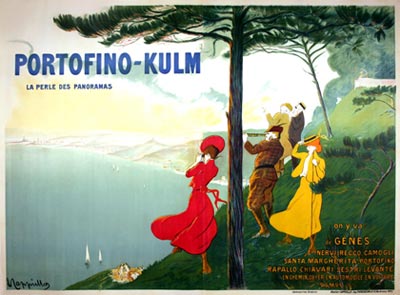
rare Cappiello stone lithograph
No poster, whether a stone lithograph, or offset lithograph, is the actual "original painting or goauche", that the image is taken from, but a 'route' to produce a reproduction of the original image in quantity. Of course, the stone lithographs of the turn of the century involved much more technique and artistry (the printing runs were also smaller). Henri de Toulouse-Lautrec took a hands on approach to working on the stones himself. He wanted to see where he could push the art, not only from the point of view of the image, but also within the boundries of the "process". A stone lithograph is no more or less valuable than a 1950's offset lithograph, by a well known artist. Its not the technique that sets the value, but the demand for the piece. What set's the demand, can be a variety of factors ie: Artist, image, place, product, rarity, condition, and other factors. Its best to work with an experienced professional to help guide and give advice for your poster purchases.

Poster Conservation of Stamford Connecticutt, where we can see top quality linenbacking in progress. The Aviation poster has been put on linen and is stretched on a frame. In the back another poster stretched on to a frame is being restored. The Girl in the foreground is using water soluble gouache crayons, respecting museum quality archival preservation of the poster.
Part - 5 - Linen-Backing explained
Professional Poster dealers specializing in antique Vintage Posters for collection will almost always archivally preserve their posters by mounting them on a linen based (artist's canvas) backing support. .A professional "linen-backer" stretches canvas on to a frame tight like a drum. At the beginning it resembles an artist's canvas on a frame ready to paint. Then to that he glues with 'reversible' water-soluble glue, 'canson' or water color smooth paper. On to these 2 surfaces, he then glues the poster, with the same glue, which also is 'ph' friendly, acid free and has 'anti fungus' elements. This prevents the poster from "yellowing" or acidifying in time, and being attacked by fungus with humidity. This process can take several days or even a week or more depending on the weather conditions as humidity can slow the process. As there are 3 layers of different material consistencies, they will dry at different speeds and it is important that the poster fully drys on the frame. This is to avoid that one of the materials could pull against the other, producing a buckling of the final product. This linen-backing process also protects the Vintage Poster from accidental tearing and folding. It acts as a support for a framer, to not touch the poster, but use the extra linen around the Vintage Poster, to press it in to the frame. This prevents unknowing framers from gluing the actual poster and ruining its value. There is usually a 2 to 3 inch margin of white canson paper on all 4 sides of the poster. However, not all posters need to be lined, nor is it a requirement in order to be able to frame the poster. Old fragile posters are best off being linen-backed and contemporary posters in perfect condition can be framed as is. Some posters are printed on paper that is too heavy to linen-back, so enquire about linen-backing when purchasing your Vintage Posters.
Part - 6 Certificates of Authenticity discussed
Many dealers and sellers of Vintage posters will claim that they provide certificates of Authenticity and you shouldn't buy a poster unless someone give you that. However, In My Humble Opinion, A certificate is really something that can only be issued by the "printer or artist" certifying that the work is by "them". After all, he can be sure he printed the poster or did the artwork on the poster. All other certificates are created by and for dealers who are really declaring that the works are original "in their opinion", which means, its only as good as the knowledge of the person stating the fact. They have no value or meaning to anyone anywhere what so ever. So Certificates are only as good as the persons' "credibility and knowledge". A receipt/invoice by a reputable company/society, stating or designating, 'exactly' what has been sold ie: date of the poster, artist, printer, is the best protection against fraud.
